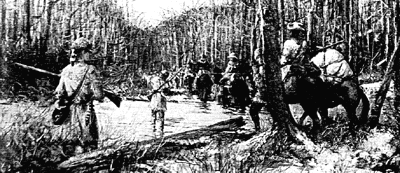The Natchez Trace Part III
by Fred Stutzenberger
Although the Trace was
used largely by boatman returning from Natchez to Tennessee, many settlers
bound of Mississippi Territory and beyond also traveled the route south.
Photo courtesy of the Federal Highway Administration.
Musketoos and nats and water very bad....
Phillip Buckner, a traveler on the Natchez Trace, 1811
Prologue:
In Part II, your trek up the Natchez Trace continues
after your rescue from highwaymen posing as missionaries. Although suffering
from an accidental, self-inflicted injury, you feel fortunate to be alive
and healing. A tense encounter with a band of Chickasaw braves leaves you
and your party apprehensive about the loss of your horses--or worse. Our
story finds you being awakened in the predawn hours by a gunshot, only
to be bowled over by a mysterious form running from the camp.
As you lie on the ground gasping for breath after having
the wind knocked out of you, you hear a frantic, yet reassuring, shout.
"Mon Dieu! Marcel! Ici! Ici!" Sputtering torches light the foliage. "Sacré
bleu, mon ami!" The Frenchman's face is indistinguishable, but by the outline
of his parson's hat, you know it is Etienne. "Lawrd, they dun killed one
'tother," you hear Lewis' familiar voice. You can gasp out only a wheezing
attempt at a reply. Etienne raises you to a sitting position. Your hunter's
frock and face are splashed with crimson. Lewis hunkers down and peers
into your face, "Hell, Hoss, you ain't gone 'n knocked your own self out
ag'in, have ye?" By now, you are able to wheeze, "No, somebody else did
it for me this time." "Well, that somebody else is lyin' right o'er har,
kickin' out 'is last war dance. Looks to be a Injun kid no mor'n 13 er
14 yars old, I reckon. You musta done some mighty close range shootin'--his
shirt's still smokin'. 'N that's why you're bloodied too, I'll bet. Hell,
ya had me all karnsarned fur nuthin'."
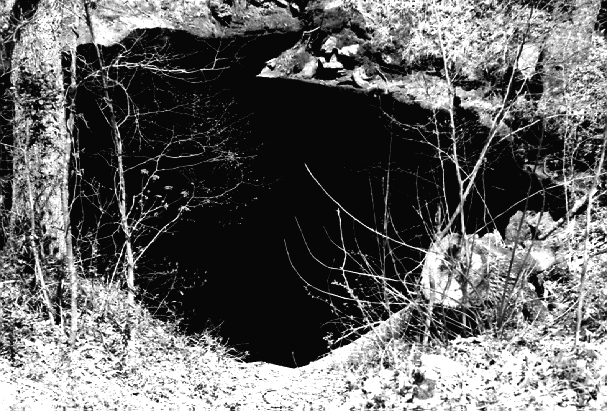
|
|
Cave Spring was a familiar landmark located near where the Trace crossed from Mississippi into the northwest corner of Alabama.
|
As the men stand looking down at the young brave, bloody
froth still oozing from his mouth and nose, the shock of what has happened
in recent minutes seems overwhelming to you. Christopher approaches "Wal,
we still got all our hosses, 'n we all still got our hair, so I reckon
we come outta this jist fine. There was two uf 'em. I got a quick shot
at t'other, but I think he got away clean." He stands swabbing his rifle
bore nonchalantly, but his hands are trembling, and you know that even
has shaken even this staunch patriarch. "Let's git things sorted out. Thar
might be more uf them young fellars around, wanting ta take back a four-footed
souvenir ta their town ta prove what a brave man they was."
In less than an hour, the crews begin to move out. You
are the last to leave the campsite. The young Chickasaw has been propped
up in a sitting position against a tree, his knife in his right hand to
provide him as much final dignity as possible. A large, metallic green
fly buzzes nosily about his face and lights to eagerly begin feasting on
the clotted bloody ooze. You wave the fly off, then, without looking back,
you mount up and urge your horse into a gallop to catch up with the others
who are already out of sight up the Trace.
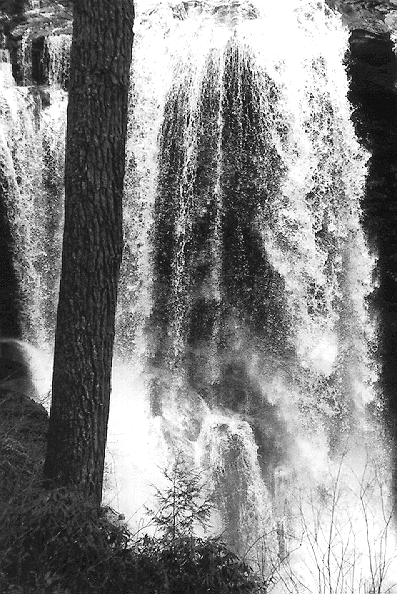
|
|
Waterfalls can be seen at several locations along the Trace as it winds through the rolling Tennessee landscape south of Nashville.
|
The next few days pass without incident. Your main concern
is for the safety of unsuspecting groups traveling south into Chickasaw
country. The accidental death of the young brave, although obviously a
normal occupational hazard in horse thievery, will surely have stirred
the wrath of the Chickasaw who will be looking for revenge. Late on the
18th day out of Natchez, you reach French Camp. The party is received in
the small settlement with great joy over the arrival of Etienne and Marcel.
The founder of the tiny settlement, Louis LeFleur, seems unperturbed at
the prospect of trouble with the Chickasaw. "The Chickasaw are our friends.
If they want to fight, they can find plenty of Osage west of the Skuna
River. No, they are our allies, for we French know how to treat our red
brothers. They come north from Nahih Waiya and south from Chuquatonchee
to trade with us. Some come from as far away as Tockshish and The Old Fields.
Oh, they get drunk sometimes, and they will, how you say, requisition things
from us from time to time, but Monsieur," he waves his arm in a sweeping
motion out over the surrounding countryside, "look at what we have requisitioned
from them!" (
Authors note: Although the Chickasaw maintained permanent
towns clustered largely along the Natchez Trace, they often ranged west
of the Mississippi to hunt buffalo and steal horses from the Osage
6.)
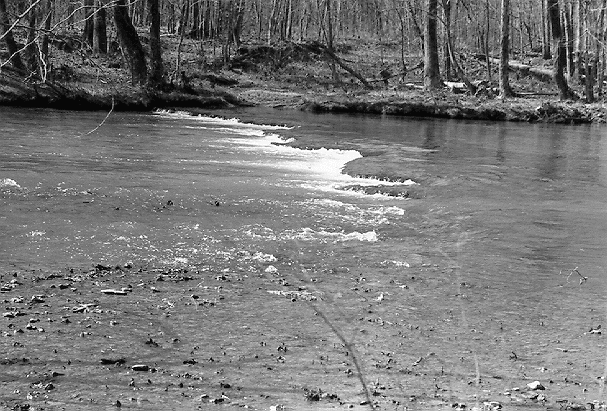
|
|
Travelers on the Trace crossed a shallow section of the Buffalo River here at Metal Ford.
|
That evening, there is a celebration, with feasting and
dancing. The aroma of venison in rich cream sauce, Cajun roast capon and
rice dishes fills the air as the fiddles squeak out their merry tunes and
the wine and brandy go to your head when the dancing commences. It is early
morning before you stagger into your bedroll. Being on the trail is first
light will be difficult indeed today.
On the afternoon of the 21st day, you reach Cave Spring
on the Mississippi-Alabama Territorial boundary. The dark coolness of the
cave is an inviting refuge from the hot sun of a cloudless day. Canteens
are rinsed and refilled from the clear trickling spring within and much
time is spent ferrying water up from the cave for the horses.
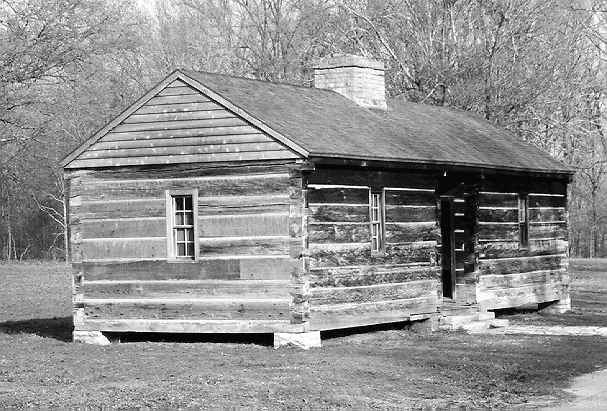
|
|
Grinder's Inn, located about 60 miles south of Nashville on the Natchez Trace.
|
As the journey resumes, the Trace seems to be gaining
altitude, with long, steep inclines and descents. Some areas cause the
horses to puff and lather despite a rather leisurely pace. On the 23rd
day, the Tennessee River comes into view. Christopher calls a halt and
explains what is ahead. "It'll cost us ta cross this h'ar river. Thar's
a ferry run by George Colbert. He sez he's a Chickasaw chief, but his Daddy
come frum Scotland 'n wuz one o' tha furst white men in this country. He's
Chickasaw alrite, 'cause he's a wily devil, but whin hit come ta bisniss,
he's all Scotsman! Anyway, let's ride on in 'n find out jist how much the
red scoundrel is gonna take us fur ta cross his ditch." (
Author's note:
George Colbert would later infurate General Andrew Jackson when he charged
him a flat $75,000 to ferry his soldiers and supply wagons across the Tennessee
River during his campaign to defend New Orleans from the British
7.)
Half a day later and three dollars apiece poorer, you
and your companions are across the river with not so much as a moccasin
getting wet. After camping for the night at Rock Springs, the Trace is
mostly uphill, long even grades interspersed with winding stretches over
which you can travel for hours and then look across to a section you passed
miles ago.
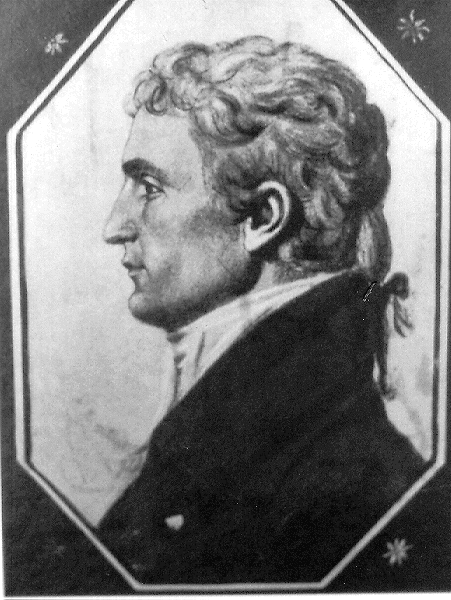
|
|
Meriwether Lewis, whose death at Grinder's Inn in 1809 remains shrouded in mystery (portrait courtesy of the U.S. National Park Service.)
|
The next day dawns cold and dreary. A steady, penetrating
mist soaks man and beast. To compound your misery, your descent into a
long valley brings you to Dogwood Mudhole, a part of the Trace infamous
for it impassable nature in wet weather. For the next mile, the going is
very slow, the horses slipping and sliding under their loads, the men cursing
as moccasins are sucked off their feet by the reddish mire. Traveler heading
south on the Trace with wagons are hopelessly stranded for the time being,
their horses collapsed in their harness. A women in one of the southbound
parties has become hysterical and shrilly threatens to start walking back
to Nashville.
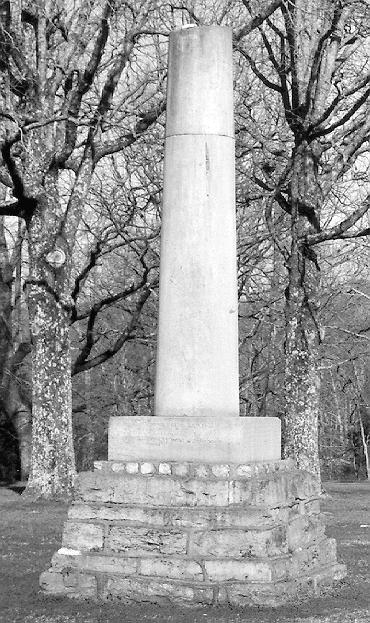
|
|
The monument that stands on the grounds of Grinder's Inn in tribute to the accomplishment and tragedy of Lewis's short life.
|
By noon of the 27th day, you cross Metal Ford on the Buffalo
River . McLish's Stand is a welcome source of supplies. The neighboring
iron works has plenty of stock for horseshoes and a blacksmith to do general
repairs. A short distance up the Trace is Grinder's Inn, a welcome stopover
for your weary crew. (
Author's note: Grinder's Inn would later become
the site at which Meriwether Lewis met his mysterious demise in 1809. Whether
the death of the bright young explorer who co-captained the Journey of
Discovery was murder or suicide remains uncertain. The monument that now
stands on the grounds of Grinder's Inn in Lewis County, Tennessee, has
a broken shaft symbolizing a promising life cut short
7.)
The inn has an ample stock of strong spirits, and although
crowded with travelers, the grounds around the main log structure provide
inviting campsites on dry and level ground. You spend your evening circulating
around, visiting several camps and exchanging tales of the road. Your bandage
is off now, your wound is healing nicely, and somehow the event that will
leave you with a permanently creased forehead seems more of a humorous
topic of conversation than it was a few days back.
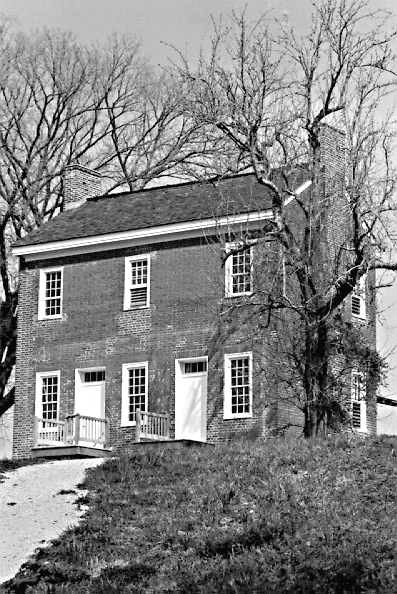
|
|
The house built by Captain John Gordon overlooking the Duck River.
|
North of Grinder's Inn, the Trace passes through Fall
Hollow with its cascading waterfall. Although it's a bit too forceful for
a shower, the crews stop for a while to cool their feet and water the horses.
Then, on the Sheboss Place, another stand for the night's camp. There is
an air of expectation among the men. Within a day or two, several will
be leaving the Trace for the final trek overland to their homelands east
of Nashville. Their last major natural obstacle is the Duck River, wide
and often quite shallow, but nevertheless formidable during flood season.
Captain John Gordon (an old Indian fighter and distinguished veteran of
the recent Coldwater and Nickajack expedition against the Cherokee in 1787
and 1794) runs a ferry across the river. While the Duck River is small
compared to the Tennessee, his charge of $2.50 for ferrying your whole
party seems quite a bargain after the gouging you took from George Colbert.
(Author's note: Although Gordon made little money
off his ferrying business, his land grants stemming from his meritorious
service in the Tennessee Indian wars along the Cumberland River left him
relatively affluent. He later became the first postmaster of Nashville
and built a large house overlooking the Duck River in 1817 after returning
from serving under Jackson in his campaign against the Creek Indians8.)
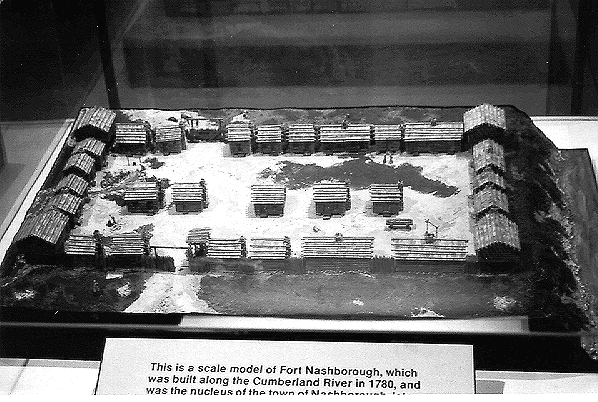
|
|
Fort Nashborough, the nucleus of the frontier settlement that was to become Nashville. (Photograph of a scale model taken with permission of the Tennessee State Museum, Nashville.)
|
After the Duck River Crossing, the men of the two crews
will begin to split off into twos and threes for the final overland trek.
Once the Tennessee Valley Divide is crossed, the threat from Chickasaw
and bandits alike is greatly reduced. Safety in numbers no longer seems
necessary, particularly since a federal army unit under the command of
Col. Thomas Butler is in the process of building an outpost on Garrison
Creek. Knowing that some of you will not see each other again for a long
time, perhaps never, the two crews hold a bit of a farewell ceremony in
camp tonight. There is a copious exchange of humorous presents (you receive
a knit wool cap with a red feather in front marking your encounter with
the tree limb) and a great deal of speechmaking punctuated by many toasts
with the remaining hard liquor. Christopher Robertson, who has been your
informal, but acknowledged, leader during the northward trek, makes a brief
speech. "Fellars, y'all bin gud 'uns, ever' one, 'n I wouldn't thank twict
'bout askin' ya ta shire any danger," he grins, "er my jug of whiskey either!"
as he passes around the jug containing the last of his hard spirits.
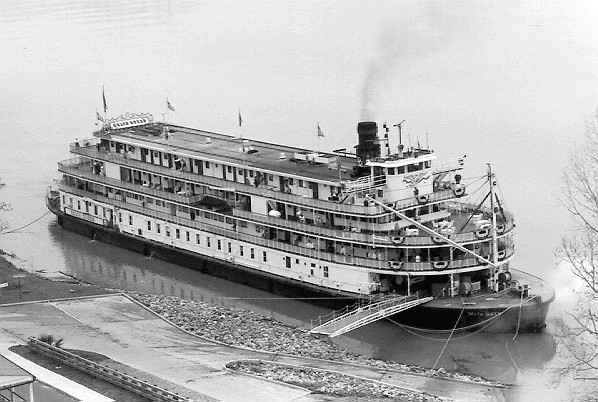
|
|
The advent of steam power ushered in the era of the big paddlewheelers that decreased the commercial importance of the Natchez Trace.
|
During the following day, the party gets smaller as men
split off for their homes or other destinations a day or two distant. On
the evening of the 32nd day, you and your remaining companions come within
sight of Fort Nashborough, the northern terminus of the Natchez Trace.
You have just walked through a fleeting page of American history. Within
little more than a decade, the advent of steam power, and its ability to
buck the river currents, would begin to diminish the economic importance
of the Trace even as it was being improved by federal funding. Before many
more years, the big river boats would ply their trade where flatboats used
to merely drift southward with the current. The affluence that steam transportation
would bring to Natchez and the other river ports created a lifestyle of
which mansions such as Rosalie are reminiscent
9.
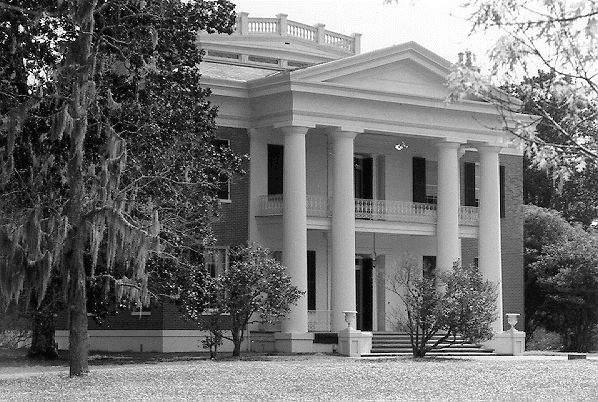
|
|
Homes such as Rosalie (Built about 1820 on the Mississippi Bluff near the site of the Fort Rosalie massacre) are reminders of the splendor which graced Natchez during the Natchez Trace era.
|
Today, the Natchez Trace Parkway winds its path of 45,000
acres across and along the old road, a road that had its beginnings in
the antiquity of buffalo migrations and in the first trade routes across
southern Americana. Its significance in the development of our nation is
indelibly, yet discreetly, preserved in the many markers, museums, and
monuments to those who have traveled before us along its route. If you
have enjoyed your mental journey along the Natchez Trace through this narrative,
wandering along the Parkway itself will be all the better pleasure.
Footnotes
6. Foreman, G. 1936.
Indians and Pioneers. University
of Oklahoma Press, Norman, OK.
7. National Park Service. 1994.
Natchez Trace Parkway
Official Map and Guide, GPO 1994-301-085-80106. U.S. Department of
the Inerior, Washington, DC.
8. Tennessee State Division of History. 1932. Placard
on the monument at the site of original post office, Nashville, Tennessee.
9. National Park Service. 1993.
Melrose, Natchez National
Historic Park Visitor Guide, U.S. Department of the Interior, Washington,
DC.
*Header quote courtesy of the U.S. National Park Service.

